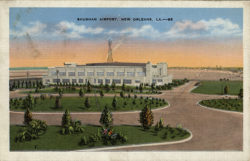Lakefront Airport
In order to accommodate seaplanes as well as land-based craft, New Orleans's Lakefront Airport was built on land dredged from Lake Pontchartrain to create a site that projects into the lake.

The Historic New Orleans Collection.
The reverse side of this promotional postcard reads "This airport, declared by aviation authorities to be the finest in the world, was built on Lake Pontchartrain, New Orleans, on land which came from the lake bottom, at a cost of $3,500,000. Longest dimension 5,400 feet. Serves both land and seaplanes."
The terminal building of Lakefront Airport in New Orleans is arguably the finest art deco structure in Louisiana.
Planned to accommodate seaplanes as well as land-based craft, Lakefront Airport was built on land dredged from Lake Pontchartrain to create a site that projects into the lake. The initial plans for the airport were drawn up by William E. Arthur of Los Angeles, California, who was replaced in 1932 by the architectural firm of Weiss, Dreyfous and Seiferth. Following Arthur’s concept, the airfield’s buildings were laid out on the triangular site in a winged arrangement symbolizing flight; the central terminal building was given a similar winged outline.
Both the exterior and interior of the terminal are lavishly ornamented with relief sculptures that allude to flight. Above the main entrance is a sculpture of man as a flying machine, flanked by window panels with similar representations; on the sidewalls are sculptures representing the four winds. Among the sculptors who created these works were Enrique Alferez, William Proctor, and John M. Lachin. Weiss, Dreyfous and Seiferth’s beautiful façade, which illustrates their mastery in the integration of sculpture and architecture, was covered in 1964 by a windowless wall in order to save the expense of needed exterior repairs and to enable the airport to function as a radiation shelter. The wall was removed during a major restoration of the terminal, completed in 2013, under the direction of architect Alton Ochsner Davis.
Much of the terminal’s interior retains its glamorous 1930s appearance, with rose-, cream-, and beige-colored marble paneling, streamlined aluminum stair and balcony railings and light fixtures, plaster friezes of mechanical tools and of cloud and sun motifs, all conveying the magical and modern aura of early flight. Murals surrounding the main lobby at the balcony level were painted by Xavier Gonzalez and depict faraway places reachable by airplane.
Funded at a cost of $4 million and supervised by the Orleans Levee Board, the airport was named—despite considerable public protest—for the board’s president, Abe Shushan (1894–1966), who had his initials inscribed throughout the terminal—reputedly in more than a thousand places—from doorknobs to roof. Shushan, a friend of Huey P. Long, was indicted for income-tax evasion. He was subsequently acquitted, but in 1939 the Orleans Levee Board nonetheless renamed the airport and ordered the removal of every trace of Shushan’s name. Shushan was jailed for mail fraud the following year.
Adjacent to the airport’s entrance is Enrique Alferez’s striking fountain. Completed in 1938, it is composed of four nine-foot-tall nude figures of cast stone representing the four winds, grouped around a hemisphere and surrounded by a pool. Three of the figures are female; the male figure, representing the north wind, initially was heavily criticized by citizens who regarded its nudity as harmful to public morals.
The airport handled its first commercial flights in 1933, ahead of its formal opening on February 9, 1934. It is now used primarily for corporate, private, and charter flights. Lakefront had no commercial passenger service from 1946 until June 2013, when Southern Airways Express began operating commercial flights to a few nearby states.
Adapted from Karen Kingsley’s Buildings of Louisiana, part of the Buildings of the United States series commissioned by the Society of Architectural Historians (www.sah.org) and published by Oxford University Press.
